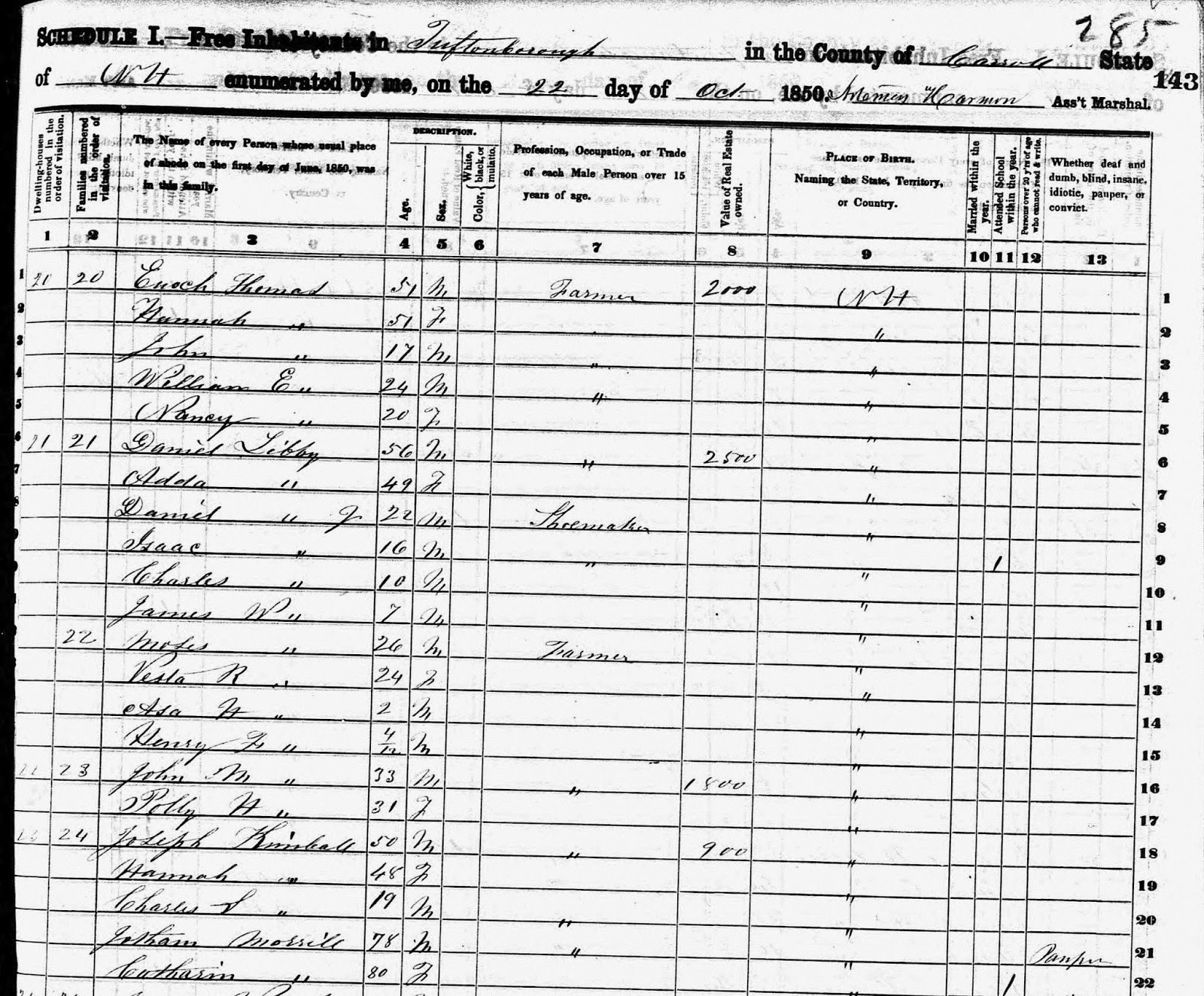Census records began in 1790 in Strafford County (which area containing Moultonboro would 50 years later be annexed into a new Carroll County). Heads of household were the only people named on all census records prior to 1850, and the surname Brown is of course ubiquitous in 18th century New England.
But as always with these blog posts, I will lay forth what I understand about her, and who the potential relatives might be, based on available records and online trees and sources.
Catherine first appears in recorded data as bride to Jotham Morrill of Moultonboro in February 1799:
She and Jotham appear on the 1850 Census, living as paupers under the care of the Kimball family of Tuftonboro, and Catherine is listed as being unable to read or write, at the age of 80:
She appears listed as mother "Katie Brown" to Statira Morrill in a Moultonboro 1890 death record, and from here we learn that Statira was born in Tuftonboro (where Catherine and Jotham had moved soon after the wedding);
According to an email I received from Tuftonboro Town Hall, Catherine, listed as "Mrs. Jonathan Morrill" died in November of 1851.
There are many census records for her husband Jotham, where she appears as the elder female in the household.
Now, it's a worthy attempt to comb through the Brown families of Moultonboro during that period to attempt to learn possible relations for the unfortunately illiterate Katie, so here goes:
1790 Moultonboro Census: The only census taken prior to Catherine's marriage, is a good starting point for looking at Brown heads of household, and if any of these men were age 35-40 by the time of this census, they would be more the likely:
- Benjamin Brown (1 male under 16, 2 males over 16, 4 females). Benjamin appears in many other subsequent censuses, and appears to have lost 2 net females for the 1800 census. He seems to no longer be accounted for after the 1820 Census, and there appears to be a Benjamin Brown buried in Moultonboro in 1828, who was born in Ipswich, Mass in 1755, and was of appropriate age.
- Blanchard Brown (1 male under 16, 1 male over 16, 4 females) - Blanchard appears in no other records, but one census backup record appears to indicate that he was born in 1750 for this census.
- Daniel Brown (3 males under 16, 1 males over 16, 3 females). Daniel stayed in Moultonborough, and the 1800 census also includes three females (but as of Sept 2022, I've discovered that Daniel had a wife Betty, and two daughters, Betsey and Nabby, living with him at the time). In 1820, he was housing a non-naturalized foreigner, and doesn't appear in any subsequent censuses. Based on census calculations, he appears to have been born between 1756 and 1765, so he would potentially qualify for parentage, if not for the lack of a 4th female listed in 1790. After speaking with local researchers, however, it was been determined that Daniel couldn't be the father, given that Daniel was likely born in 1756, and the three females on the 1800 census must have been Betsey, Nabby, and Betty, which would exclude Catherine.
- John Brown (1 male under 16, 1 male over 16, 4 females). John appears to have been born in 1750, and has census records continuing through 1820. There appears to be a John Brown the 2nd born in 1792, according to burial records. This could have been John's son, I suppose. Now, in the next census, 1800, Catherine is living with her new husband Jotham Morrill (next door to his possible brother William Morrill), and John Brown appears to be living very close by, so perhaps this gives John a bit more potential as her father? Who knows, really.
In neighboring Tuftonboro, there appear to have been Browns as well: heads of household with biblical names like Moses and Obediah. Also, there appear to be Brown Family Cemeteries in neighboring Wolfeboro and Moultonboro.
So, the six men above appear to be possible fathers to Catherine, with Benjamin, and John being the most likely candidates.
It's interesting to me to note that a Lydia Brown (1779-1840) of Sandwich married Nicholas Bean of my Sandwich Beans, and had a daughter Rebecca Bean who married John Elliott, of my Sandwich Elliotts. I wonder if this Lydia may have been related to Catherine? They were of even age to have been sisters or cousins.
Further, there appear to have been a great number of Brown families in Berwick, Maine, the likely birthplace of Catherine's husband Jotham. It is entirely possible they were both from Berwick originally.
Catherine and Jotham's son, Jonathan Smythe Morrill (my 3rd great grandfather), married Sally Elliot of neighboring Sandwich, and moved to Portland Maine, where my family is from, as are a large number of Portland, Maine Morrills.
































